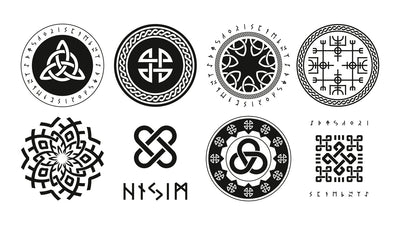Embracing Heritage: The Timeless Beauty of Viking Jewellery
The era of ancient Scandinavian society was really when the history of Viking ornaments began. Even prior to the age of Vikings (800-1000 AD), bone, wood and bronze were used to make simple adornments by those in the north. However, it was during the Viking era that things really took off.
On their voyages, Viking warriors brought home with them spoils from distant lands. The loot consisted of precious metals, gemstones, shells, ingots and other unique materials. This sudden upsurge in riches fueled creativity among the craftsmen of the period, leading to some of the most renowned Viking jewellery.
The History of Viking Jewellery
To better understand Viking jewellery, we must first step back a bit in history. Imagine the Viking warriors crossing the stormy seas,on a quest for riches. In Viking times, jewellery acted as a symbol of status and power. Many Viking pieces have been discovered by archaeologists, ranging from brooches to metal necklaces.
Take, for example, the famous Hiddensee treasure, which is a collection of jewellery from Viking times discovered in the German island of Hiddensee. This collection includes several silver bracelets, some plain and some adorned. They were used as amulets that people used to believe would ward off evil spirits and bring good luck to the wearer. The hoard also included several amulets in the shape of small Thor's hammers, which were tiny replicas of the mighty Mjölnir. Each pendant was believed to offer protection and guidance to those who wore them. Each rune has its own meaning and power, and to wear such amulets would be a way for a Viking to garner that power in his life.
Below we'll discuss some of the common Viking jewellery symbols and what they signified for the wearer.
The Hammer of Thor
The hammer of Thor - mighty Mjölnir. More than a symbol, it was a representation of strength and protection. Wearing Mjölnir meant one had Thor with them always, ready to rescue them from any foe who dares challenge them. It is a reminder for one to stand tall in the face of adversity and not to back down from a fight.
Raven
Ravens were considered to be sacred birds in Norse mythology, and were often associated with Odin. They symbolise wisdom, knowledge, and the ability to see beyond the present.
The Wolf
The wold amulet signifies a wild, fierce, and untamed creature. In Viking culture, the wolf was revered as a symbol of ferocity and loyalty; it showed the spirit of the warrior, always on the ready to defend its pack. Wearing the image of a wolf symbolised its strength and resilience, and being loyal to one's kin, no matter the cost.
Tree of Life (Yggdrasil)
Yggdrasil is the great world tree that is believed to connect the nine realms in Norse mythology. It symbolises how all things are connected and the cycle of life, death, and rebirth.
Valknut
Also known as the "knot of the slain," the Valknut is a symbol associated with Odin, All-Father of Norse mythology. It became known as a symbol of courage, sacrifice, and the warrior spirit.
Unveiling the Enigmatic Splendor of Odin's Cave: A Tribute to the Timeless Legacy of the Vikings
Greetings! Let’s learn a little more about us.
Prepare to embark on a transcendent voyage that transcends the boundaries of time, where the captivating allure of ancient legends converges with the contemporary world. Welcome to Odin's Cave, an ethereal sanctuary that pulsates with the essence of Norse mythology and the indomitable spirit of the Vikings. Join us as we delve deeper into the realm of Odinscave.com and unlock the myriad reasons why it has become the ultimate haven for enthusiasts seeking to immerse themselves in the rich tapestry of Viking heritage.
Unveiling a Bountiful Treasure Trove:
Odin's Cave is not just an ordinary online store; it is a veritable repository of history, mythology, and exquisite craftsmanship. As you traverse the virtual corridors of this extraordinary cave, a breathtaking collection of meticulously curated and authentically Viking-inspired artifacts awaits you. From intricately designed jewelry that exudes timeless elegance to meticulously crafted home decor that echoes the grandeur of the Viking era, each item is a testament to the artistic finesse and meticulous attention to detail that characterized this extraordinary civilization.
Oour Commitment to Uncompromising Authenticity:
What sets Odin's Cave apart from its counterparts is its unwavering commitment to authenticity. Each artifact in their carefully curated collection is sourced from skilled artisans and craftsmen who share an unwavering passion for historical accuracy. By diligently studying and revering the rich tapestry of Norse traditions, Odin's Cave ensures that every piece not only encapsulates the essence of Viking culture but also embodies the valor and mysticism of the Norse gods and warriors. With every acquisition, patrons acquire a tangible piece of history, forging a connection with the past that transcends time.
We’re A Vibrant Community of Viking Enthusiasts:
Beyond its role as a digital marketplace, Odin's Cave serves as a thriving community that unites individuals bound by a shared fascination for Norse mythology and the indomitable Viking spirit. Through their engaging blog, dynamic social media presence, and captivating events, Odin's Cave fosters a sense of camaraderie among its diverse customer base. Enlightening articles, enthralling tales, and spirited discussions bring the Viking world to life, inviting enthusiasts from all walks of life to partake in an enthralling journey of discovery and cultural exploration.
An Unparalleled Shopping Experience:
Odin's Cave understands the significance of a seamless and immersive shopping experience. Their meticulously designed website provides visitors with an intuitive interface to navigate their vast collection, unravel the symbolism behind each artifact, and make informed choices. Moreover, the dedicated team at Odin's Cave places paramount importance on providing exceptional customer service, ensuring that every inquiry is promptly addressed and every order is handled with utmost care. Shopping at Odin's Cave is not merely a transaction; it is a captivating odyssey that leaves a lasting impression.
Step into the enigmatic splendor of Odin's Cave, a digital portal that bridges the gap between antiquity and the present, myth and reality. Through its authentic Viking-inspired collection, unwavering commitment to historical accuracy, vibrant community engagement, and unparalleled shopping experience, Odin's Cave has emerged as the quintessential destination for those seeking to immerse themselves in the enduring spirit of the Vikings. Whether you are a history aficionado, a mythology enthusiast, or simply someone who appreciates the beauty and resilience of Viking culture, Odin's Cave invites you to embark on a transformative journey where the echoes of the past reverberate in the present. Join the thriving community, explore the treasure trove, and witness the saga unfold before your very eyes. Your encounter with Odin's Cave will be nothing short of extraordinary.
What Jewellery did Vikings wear?
The Vikings created and crafted many different types of exquisite and elaborate jewellery, including bracelets, rings, and necklaces. They used a huge variety of materials such as bronze, iron, gold, gemstones, silver, amber, and even resin for their Nordic jewellery. During the early stages of the Viking era, these adornments were relatively modest; however, as time progressed, they evolved into more intricately detailed and refined pieces.
Viking jewellery was not only used as pretty adornments but as a currency for trade. Valued for their craftsmanship and precious materials, items such as bracelets, rings, and necklaces were used as a form of currency in exchange for goods and services. Nordic jewellery frequently served as a marker of social standing, with those wearing elaborate and well-crafted pieces demonstrating a higher status in society.
Arm Rings
Arm rings were routinely worn by both Viking men and women. These metal bands, often made of silver or gold, were worn around the upper arm or wrist. The size and intricacy of arm rings varied, with some featuring elaborate engravings or motifs. Some were spiral-shaped, wrapping around the arm multiple times for a secure hold, convenient for breaking into sections during trade transactions. Others were shorter, covering about three-quarters of the arm and were preferred as currency for their plain, flat design, making them easier to break apart as needed.
Brooches
Brooches were an equally popular form of Nordic jewellery and were worn by many Viking women. They were used to fasten clothing such as cloaks or the apron dresses that they wore. These brooches, typically made of bronze, silver, or gold, often had intricate filigree, animal symbols, or geometric patterns. Viking women often wore pairs of brooches, one on each shoulder, as a further way to showcase their wealth.
Beard and Hair Rings
Wearing beard and hair rings was a customary practice among Viking men. These rings were usually woven into their facial hair and braids and were often made of silver or gold. Beard and hair rings were often intricately designed, featuring runes, patterns or motifs [1].
Necklaces and Neck Rings
Necklaces were made from various different materials, including glass beads, shells, amber, and precious metals like silver or gold. Neck rings, usually made of silver or gold, were sometimes elaborately embellished with engravings or gemstones. Necklaces often featured pendants crafted from glass beads, precious stones, resin, Baltic amber, and small metal charms. Glass emerged as the predominant material for pendant production, often manufactured in large quantities for this purpose. These pendants frequently served as souvenirs, gifts, or symbols of Nordic religious significance.
Pendant and Amulets
The Vikings wore a wide variety of amulets including including Mjolnir pendants, Valknut pendants, Yggdrasil pendants, and more. Thor's hammer pendant appears to have been the most commonly worn by ancient Norsemen, and has been found in many Viking graves. Examples of other pendants include miniature weapons like axes and arrowheads, perforated coins, depictions of the Tree of Life, crosses, and symbols such as the Valknut.
Pendants often featured beads, commonly made from amber or glass. Despite their widespread availability and affordability in modern times, archaeological findings from Viking burial sites indicate that these ornaments were scarce and only one or two were added to each pendant.
Resources:
[1] https://www.worldhistory.org/article/1388/vikings-jewelry-weapons--social-change-at-the-viki/
Viking symbols and their meaning
Viking culture is well-known for its use of symbols, which hold deep significance in their beliefs, traditions, and way of life. These ancient Norse symbols, often depicted in their art, jewellery, and even on runestones, provide valuable insights into the values and beliefs of the Viking people. We briefly explore some of the most prominent Viking symbols and their meanings, looking at the cultural and spiritual significance they held for the Norse people.
The Hammer of Thor (Mjölnir)

Perhaps one of the most recognisable Viking symbols, the Hammer of Thor, or Mjölnir, is the weapon of Thor, the god of thunder. This symbol is often worn as a protective amulet and is believed to invoke the power and protection of Thor against enemies and evil forces. It also symbolises strength, courage, and protection.
Huginn and Muninn: The Ravens of Norse Mythology
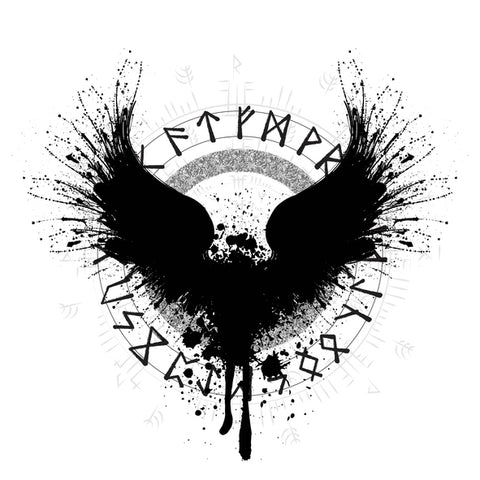
In Norse mythology, Huginn and Muninn are two iconic symbols that hold great significance in the lore of the Vikings. These revered creatures, often depicted as ravens, are closely associated with Odin. Huginn and Muninn are not merely symbolic representations but are also considered companions and messengers of Odin. According to Norse mythology, these ravens fly across the world each day, gathering information and bringing messages to Odin in his hall of Valhalla. While Huginn represents "thought," Munin symbolizes "memory."
The Valknut
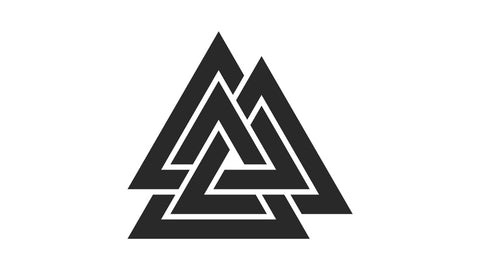
The Valknut, also known as Odin's Knot, is a symbol consisting of three interlocking triangles. It is closely associated with Odin, the Norse God, and is often interpreted as a symbol of Odin's power to bind and unbind the fates of men. It is also thought to represent the interconnectedness of life, death, and destiny in Norse mythology.
Fenrir
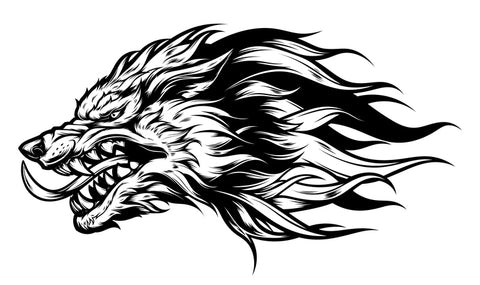
Fenrir, also spelt Fenrisúlfr, is a monstrous wolf in Norse mythology. He is the son of the god Loki and the giantess Angrboða, making him the sibling of the serpent Jörmungandr and the goddess Hel. Fenrir is depicted as a fearsome and powerful creature, destined to bring about chaos and destruction during Ragnarök, the Norse apocalypse. He is often seen as a symbol of chaos and the uncontrollable aspects of the universe in Norse mythology.
Helm of Awe (Ægishjálmr)
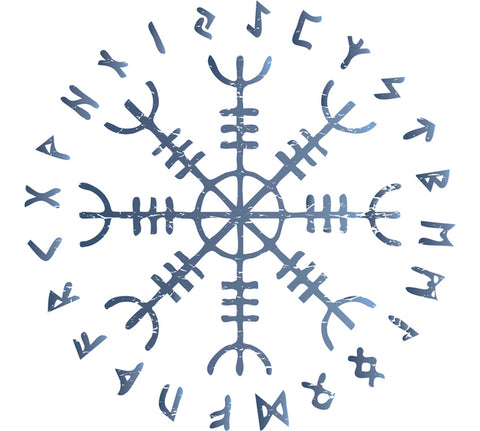
The Helm of Awe is a symbol of protection and strength. It is believed to scare away your enemies and offer protection to the wearer. The symbol is often depicted as a circular array of interlocking arms or spikes.
Vegvisir (Viking Compass)
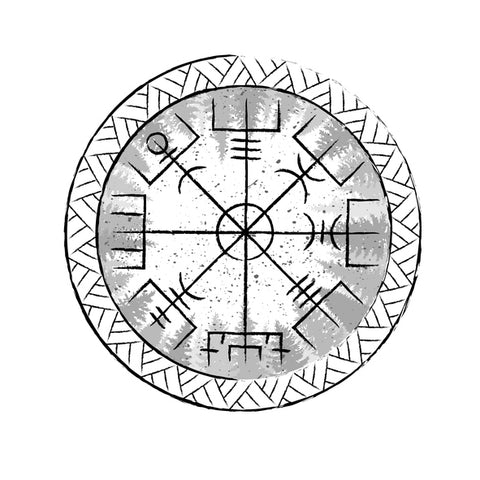
The Vegvisir is a symbol of navigation and guidance. It is thought to help the bearer find their way through stormy weather or difficult conditions, both literally and metaphorically. It is often depicted as a stylised compass with runic symbols surrounding it.
Yggdrasil (The Tree of Life)
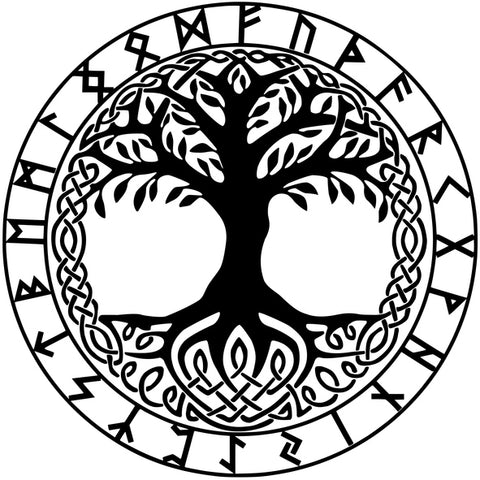
Yggdrasil is the tree that connects the nine worlds of Norse mythology. It symbolises the interconnectedness of all things in the universe and represents the cycle of life, death, and rebirth. Yggdrasil is often represented as a massive ash tree with its roots extending into the underworld and its branches reaching up to the heavens.














